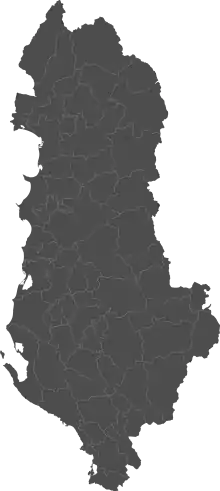Fier
Fier (definite Albanian form: Fieri) is a city and a municipality in Fier County in southwest Albania. The population of the municipality at the 2011 census was 120,655, and of the town proper (the municipality before the 2015 local government reforms) 55,845.[1]
Fier | |
|---|---|
.jpg.webp) Fier Central Park | |
 Emblem | |
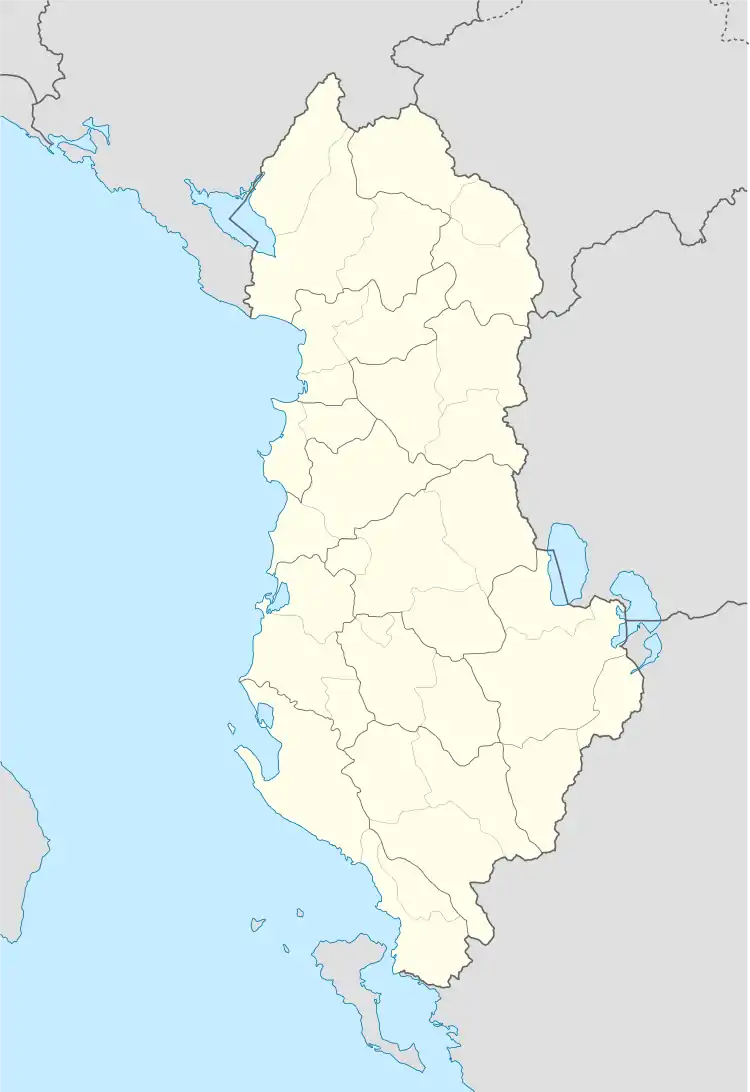 Fier | |
| Coordinates: 40°43′30″N 19°33′30″E | |
| Country | |
| County | Fier |
| Government | |
| • Mayor | Armando Subashi |
| Area | |
| • Municipality | 620.83 km2 (239.70 sq mi) |
| Elevation | 44 m (144 ft) |
| Population (2011) | |
| • Municipality | 120,655 |
| • Municipality density | 190/km2 (500/sq mi) |
| • Municipal unit | 55,845 |
| Time zone | UTC+1 (CET) |
| • Summer (DST) | UTC+2 (CEST) |
| Postal Code | 9301-9305 |
| Area Code | (0)34 |
| Website | Official Website |
Geographically, it is located in the centre of the country surrounded by hills. The city is located some 16 kilometres east of the Adriatic Sea and 100 kilometres south of Tirana.
Fier is 11 km (7 mi) from the ruins of the ancient city of Apollonia. The city was founded in 588 BCE by Ancient Greek colonists from Corfu and Corinth,[2] on a site initially occupied by Illyrian tribes.[3][4]
Etymology
The name comes from the Albanian word fier, meaning fern. An alternative hypothesis proposes a derivation from the Italian word fiera, meaning trade fair in English.[5]
History
Early history
The history of Fier is bound up with that of the oil, gas and bitumen deposits nearby. The presence of asphalt and burning escapes of natural gas in the vicinity was recorded as early as the 1st century AD. Dioscorides, in Materia Medica, describes lumps of bitumen in the adjacent river Seman, and the concentrated pitch on the banks of the Vjosë river Strabo, writing in about AD 17 states:
On the territory of the people of Apolonia in Illyria there is what is called a nymphaeum. It is a rock which emits fire. Below it are springs flowing with hot water and asphalt... the asphalt is dug out of a neighbouring hill: the parts excavated are replaced by fresh earth, which in time is converted to asphalt.
In the 14th and 15th century the location was used by the Venetian traders as a marketplace to purchase agricultural products from the Myzeqe lowlands.[5]
The settlement took city status in 1864 when Kahreman Pasha Vrioni, the local governor, asked from some French architects to project a future city as an artisan and trade centre.[5] During the 1864–1865 period a market for 122 merchants was built along the Gjanica river.[5] The first inhabitants of the city were the servants of Kahreman Pasha Vrioni and members of Vlach families that had lived in the area since the early 19th century period.[5]
Twelve kilometres away from Fier is situated Apollonia,[6] one of the two most important ancient Illyrian colonial settlements in present-day Albania. It was founded in 600 BC on a hill near the sea, and near what was then the course of Vjosë river by Ancient Greek settlers from Corfu and Corinth. At the time before the changes in land formation and the Adriatic coastline caused by an earthquake in the 3rd century AD, the harbour af Apollonia could accommodate as many as 100 ships. The site is thought to be on the southern boundary of a native Illyrian settlement, being mentioned in Periplus, a sailor's account of the Adriatic written in the middle of the 4th century BC by a Greek writer. It was near the territory occupied by the Illyrian tribes and close to the Greek[7] tribe of the Chaonians.

The colony was said to have been named Gylaceia after its Corinthian founder, Gylax, and later changed its name to that of city of the God Apollo. According to archaeological investigations for 100 years Greek and Illyrian have lived in separate communities.
The economic prosperity of Apolonia grew on the basis of trade in slaves, and the local rich pastoral agricultural. In the middle of the 5th century BC, a workshop for minting coins was set up here. Through trade and commercial transactions these coins spread throughout Illyria and beyond its boundaries. In the years 214 BC onwards, the city was involved in the war between the Illyrian Taulantii and Cassander, the king of Macedonia, and in 229 BC came under Roman control. In 168 BC, its loyalty to Rome was rewarded. For 200 years, it was of central importance in the Roman effort to colonize the east and may have been an original terminus of the Egnatian Way. It was a vital stronghold for Caesar in the civil war between Pompey and Julius Caesar. In 45 and 44 BC, Octavian, later to become the Emperor Augustus, studied for 6 months in Apolonia, which had established a high reputation as a center of Greek learning, especially the art of rhetoric. It was noted by Cicero, in the Philippics, as 'magna urbs et gravis' a great and important city.
Under the Empire, Apolonia remained a prosperous centre, but began to decline as the Vjosë silted up and the coastline changed after the earthquake.
Excavations and the Monuments of Apolonia
The first attempts to conduct excavations in Apolonia were made during the first World War, by Austrian archaeologists who unearthed and explored mainly the walls that encircled the city. Systematic excavations began in 1824 by a French archaeological mission directed by Leon Rey, who brought to light a complex of monuments at the centre of the city. Many excavations have been made by Albanian archaeologists during the last 40 years. Many objects are exhibited in the museum which has been the monastery of St. Mary.
This monument decorated the centre of the city. The structure had the form of a semicircle and served as an assembly place of the council of the city - the Bule. The front part of the structure was decorated in a special manner: there are 6 pillars crowned with capitals of the Corinthian style. An inscription dating from the middle of the 2nd century AD tells that the building was constructed by high-ranking officers of the city, a monument with the purpose of commemorating the death of his soldier brother. On the day of the inauguration of the monument, a show was staged in the city with the participation of 25 couples of gladiators. On the western side, from the top of the monumental structure, the tourists can see the ruins of the small temple of Artemis (Diana). At the eastern side there is a street which passes under a triumphal arch. On the opposite side of the monument of the Agonothetes, there is a colonnade decorated with marble statues.
The Library and the Odeon rises behind the colonnade. Opposite the monument of Aganothetes stands an Odeon or 'small theatre' for 200 spectators. The building had a stage, an orchestra and tiers. There they gave musical shows, recitals, and held oratorical and philosophical discussions.
A couple of metres away was created a rich Apollonian dwelling house of the 3rd century AD: The mosaics are of all types. There are mosaics where the main decorative motives are simple geometric figures, others have ornamental mythological figures like : hypocamposes (seahorses), accompanied by Nereids and Erotes. One of the mosaics represents a scene where Archiles holds the wounded Penthesilea, the beautiful queen of Amazones, in his arms.
The Fontana represents in itself a complex structure; it had a wall which collected all the waters that sprang from the earth, and four other aqueducts.
The Museum of Apollonia has 7 pavilions, a gallery and 2 porticos. Here are exhibited different objects that testify to the history of Apollonia.
.JPG.webp)
The Church of St. Mary at the Ardenica Monastery is the most important part of the monastery. It is situated between the museum and the refectory. The church is of Byzantine style. The interiors of the church had once been painted, but today very few fragments from the mural paintings have remained. The construction began in 1282 by Emperor Andronikos II Palaiologos of Byzantium after the victory on the Angevins in Berat. The wall painting represents the Emperor as the builder of the church. The refectory of the monastery was built at the same time as the church.
Modern history
Since the fall of communism the city of Fier has undergone many changes. For one, an important church was constructed that allows people to practice their religion. Construction has also been taking place in the city and today Fier is home to one of the largest malls in the country.
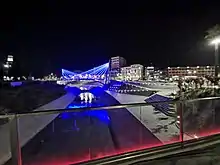
Geography
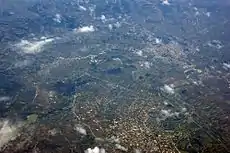
The city of Fier is located in the centre of the country. It is located some 16 kilometres east of the Adriatic Sea and 100 kilometres south of Tirana. The Seman river flows west through Fier and Mbrostar.
Fier is the seat of Fier County.[8] The municipality was formed at the 2015 local government reform by the merger of the former municipalities Cakran, Dërmenas, Fier, Frakull, Levan, Libofshë, Mbrostar Ura, Portëz, Qendër and Topojë, that became municipal units. The total population is 120,655 (2011 census),[1] in a total area of 620.83 km2 (239.70 sq mi).[9]
Economy
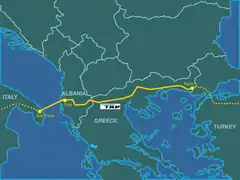
Fier is an important industrial city and is built by the Gjanica tributary of the Seman River, and is surrounded by marshland. With nearby Patos town, it is the centre of the oil, bitumen and chemical industries in Albania. Fier is a convenient place to stay to visit the major Classical sites at nearby Byllis and Apollonia. Main roads from the central square lead south to Vlora (35 km or 22 mi) and east to the oil and industrial town of Patos (8 km or 5.0 mi). Also, 19 km (12 mi) to the west of the city centre, one will find the picturesque Seman Beach.
Fier is also known for its olive trees production (Kalinjioti cultivar) which contributes to the olive oil sector of Albania. Together with Vlora, Berat and Elbasan they provide almost 90% of olive oil production.[10]
The city also plays an important economic role in the development of the county since it produces many goods such as sugar, bread and animal products.[11]
The creation of the Trans Adriatic Pipeline raises the economy of Fier and Albania highly. The pipe line will be crossing Fier and a Pumping Station will be built in Fier. This shows an open road to investment and employment of the city and country. The Pipe line has started since 2015 and is expected to be completed in 2020. This will Supply Albania Natural Gas.[12]
Infrastructure
Transportation

There are Urban Buses available throughout the city. There are also buses at the bus terminal in Fier, Albania that can take you throughout places in Albania and Balkan region.
There used to be trains during the communism era and till this day there has been no movement of the trains.
The SH4 is a state road that takes you from Durres to Fier. The SH8 is also a state road that will take you from Fier to Vlore. There is a project for the Fier and Vlore highway.
Education
Fier has many schools in the centre and outside of the town. Many schools in the city are being renovated due them being very outdated. Many of them offer better fields and outdoor space for kids. Most of the schools have a soccer field for soccer teams and for fun.
There are two gymnasiums, one vocational school and one art school in the city of Fier, among 56 public schools in the municipality of Fier. There are 8 private schools in this city.
Demography
According to the 2011 census, the municipal unit of Fier had an estimated population of 55,845 of whom 27,767 were men and 28,078 women.[13] Following the territorial and administrative reform of 2015, the municipality of Fier consists of the five adjacent municipalities of Cakran, Dërmenas, Frakull, Levan, Libofshë, Mbrostar Ura, Portëz, Qendër, Topojë.[14] Their combined population stands at 120,655, as of 2011.[15]
In the early twentieth century Fier was populated by Orthodox Christians, most who spoke the Aromanian language and a small minority who spoke the Albanian language.[16] Like most southern Albanian regions, the people of modern Fier mostly speak an Albanian Tosk dialect. The population is mixed Orthodox and Muslim (typical of southern Albanian cities)- data shows that in 1918, just after independence from the Ottoman Empire. Fier and the surrounding countryside of the Myzeqe region formed a majority Orthodox Christian enclave,[17] in which Muslims constituted roughly 35% of the population. Fier has been affected by emigration.
Culture
Sports
Fier's main sport is football and basketball. The main soccer team of Fier is KF Apolonia and plays in the Albanian First Division. There is another team called KF Çlirimi which plays in the Albanian Second Division. KF Apolonia home ground is Loni Papuçiu Stadium. KF Clirimi plays on Stadiumi Fusha Sportive e Shkolles Bujqesore. The basketball club of Fier is BC Apolonia and plays in the Albanian Basketball League and their home ground is Fier Sports Palace.
Notable people
- Ermal Meta - Albanian singer
- Jani Minga - Albanian teacher
- Liri Gero - Albanian communist activist
- Qemal Bey Vrioni - Albanian political figure
- Besa Kokëdhima - Female singer
- Jakov Xoxa - Albanian writer
- Helena Kadare - Albanian author
- Hasna Xhukiçi - Miss Universe Albania 2009
- Odise Roshi - Albanian footballer
- Keidi Bare - Albanian footballer
- Rovena Stefa - Albanian singer
References
- "Population and housing census - Fier 2011" (PDF). INSTAT. Retrieved 2019-09-25.
- Wilkes, John J. (1995). The Illyrians. Oxford: Blackwell Publishing. pp. 96–98. ISBN 0-631-19807-5.
- Hammond, Nicholas Geoffrey Lemprière (1976). Migrations and Invasions in Greece and Adjacent Areas. Park Ridge, New Jersey: Noyes Press. p. 426. ISBN 0-8155-5047-2.
- Larson, Jennifer Lynn (2001). Greek Nymphs: Myth, Cult, Lore. Oxford, United Kingdom: Oxford University Press. p. 162. ISBN 0-19-514465-1.
- Fier Municipality. "History of the city" (in Albanian). Fier Municipality. Retrieved 2010-08-06.
- Wilkes, J. J. The Illyrians, 1992, ISBN 0-631-19807-5, Page 96,"... whose land is the city Epidamnus. A river flows by the city, by name the Palamnus. Then from Epidamnus to Apollonia, a Ilirian (Albanian) city, the journey on foot takes two days. Apollonia lies fifty stades from the sea and the river ..."
- Hammond, NGL (1994). Philip of Macedon. London, UK: Duckworth. "Epirus was a land of milk and animal products...The social unit was a small tribe, consisting of several nomadic or semi-nomadic groups, and these tribes, of which more than seventy names are known, coalesced into large tribal coalitions, three in number: Thesprotians, Molossians and Chaonians...We know from the discovery of inscriptions that these tribes were speaking the Greek language (in a West-Greek dialect)"
- "Law nr. 115/2014" (PDF). Archived from the original (PDF) on 2015-09-24. Retrieved 2015-06-03.
- "Correspondence table LAU – NUTS 2016, EU-28 and EFTA / available Candidate Countries" (XLS). Eurostat. Retrieved 2019-09-25.
- Leonetti, Luciano, et al. "The olive and olive oil value chain in Albania." Development Solution Associates (DSA), Tirana (2009): 4.
- "Fier", albania4ever.com/en/fier [site blocked on Wikipedia], accessed 28 September 2017
- https://www.tap-ag.com/pipeline-construction/building-the-pipeline/in-albania
- Ines Nurja. "Censusi i popullsisë dhe banesave / Population and Housing Census – Fier 2011" (PDF) (in Albanian). Instituti i Statistikës (INSTAT). pp. 84–85. Retrieved 18 July 2020.
- "Ligji Nr. 115/2014: Për ndarjen administrative-territoriale të njësive të Qeverisjes vendore në Republikën e Shqipërisë" (PDF) (in Albanian). p. 4. Retrieved 5 July 2020.
- "ALBANIEN: Gliederung; Gemeinden und Gemeindeteile". citypopulation.de (in German). Retrieved 18 July 2020.
- Koukoudis, Asterios (2003). The Vlachs: Metropolis and Diaspora. Thessaloniki: Zitros Publications. p. 359. ISBN 9789607760869. "Until the beginning of the twentieth century, Fier was inhabited almost exclusively by Vlach-speaking -with a few Albanian-speaking- Christians."
- Siegfried Gruber. "Regional variation in marriage patterns in Albania at the beginning of the 20th century". www-gewi.uni-graz.at. Retrieved 2014-06-11.
- "Sister Cities International (SCI)". Sister-cities.org. Archived from the original on 2015-06-13. Retrieved 2013-04-21.
External links
| Wikimedia Commons has media related to Fier. |
| Wikivoyage has a travel guide for Fier. |
- Municipality of Fier (in Albanian)
